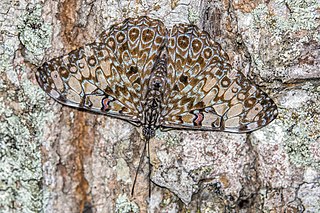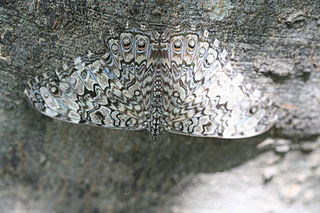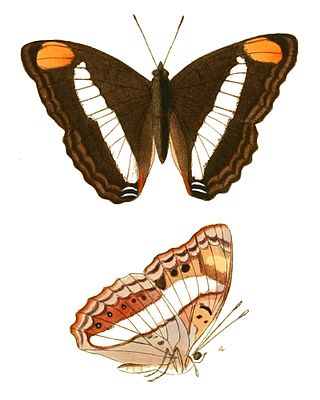
Papilio multicaudata, the two-tailed swallowtail, is a species of the family Papilionidae found in western North America from British Columbia to Central America.

Cracker butterflies are a Neotropical group of medium-sized brush-footed butterfly species of the genus Hamadryas. They acquired their common name due to the unusual way that males produce a "cracking" sound as part of their territorial displays. The most comprehensive work about their ecology and behavior is that of Julian Monge Najera et al. (1998). The genus was erected by Jacob Hübner in 1806.

Adelpha californica, the California sister, is a species of butterfly in the family Nymphalidae. They are common in California, but can also be found in western Nevada and Oregon, as well as in northern Baja California. The upper surfaces of their wings are dark brown to black with wide cream white bands dissecting both wings and two orange patches near the tips of the forewings. The underside is variously colored with browns, blue, orange, and white. A. californica is unpalatable to predators and is part of a large mimicry complex.

The common wood-nymph is a North American species of butterfly in the family Nymphalidae. It is also known as the wood-nymph, grayling, blue-eyed grayling, and the goggle eye.

Hamadryas guatemalena, also known as the Guatemalan cracker or Guatemalan calico, is a species of butterfly in the family Nymphalidae. It is found from southern North America to central South America.

Euptoieta claudia, the variegated fritillary, is a North and South American butterfly in the family Nymphalidae. Even though the variegated fritillary has some very different characteristics from the Speyeria fritillaries, it is still closely related to them. Some of the differences are: variegated fritillaries have two or three broods per year vs. one per year in Speyeria; they are nomadic vs. sedentary; and they use a wide range of host plants vs. just violets. And because of their use of passionflowers as a host plant, variegated fritillaries also have taxonomic links to the heliconians. Their flight is low and swift, but even when resting or nectaring, this species is extremely difficult to approach, and, because of this, its genus name was taken from the Greek word euptoietos meaning "easily scared".

Hamadryas amphinome, the red cracker, is a species of cracker butterfly in the family Nymphalidae, native to regions of North and South America.

Hamadryas arinome, the turquoise cracker, is a species of cracker butterfly in the family Nymphalidae. The species was first described by Hippolyte Lucas in 1853. It is found from Mexico south to the Amazon basin.

Hamadryas laodamia, the starry night cracker or starry cracker, is a species of cracker butterfly in the family Nymphalidae. It can be found from Mexico to the Amazon basin, but is most common in lowland forest in the Caribbean area.

Hamadryas feronia, the blue cracker or variable cracker, is a species of cracker butterfly in the family Nymphalidae. It is found in the southern parts of North America and South America and southwards Brazil.

Anthanassa frisia, the Cuban crescentspot, Cuban checkerspot or Cuban crescent, is a butterfly of the family Nymphalidae. Subspecies tulcis is known by the common names pale-banded crescent or Tulcis crescent; it is treated as a species by some authors.

Fountainea nobilis, the noble leafwing, is a species of Neotropical butterfly belonging to the family Nymphalidae, Charaxinae subfamily.

Asterocampa idyja, the cream-banded emperor, is a species of butterfly in the family Nymphalidae.

Hamadryas februa, the graycracker, is a species of cracker butterfly in the family Nymphalidae. It is found from Argentina north through tropical America to Mexico. Rare strays can be found up to the lower Rio Grande Valley in southern Texas. The habitat consists of subtropical forests, forest edges and cultivated areas with trees.

Doxocopa pavon, the Pavon emperor or Pavon, is a species of butterfly in the family Nymphalidae. They can be found from Paraguay in South America up to Texas in the southern United States. They are generally brown in their overall coloration, with two bands of white straddling the middle of the upper surfaces of the wings, and a patch of orange on the tips of their forewings. The upper surfaces of the wings of the males are overlaid by an iridescent blue-purple sheen. The females of the species closely resemble members of the unrelated genus Adelpha.

Marpesia zerynthia, the waiter daggerwing, is a species of butterfly in the family Nymphalidae. Primarily found in Mesoamerica, it can also be observed in regions slightly north and south of this area.

Hamadryas iphthime, the ringless blue cracker or brownish cracker, is a species of cracker butterfly in the family Nymphalidae. It was first described by Henry Walter Bates in 1864. It is found in Mexico, Central America and parts of northern South America.
Dalechampia triphylla is a vine in the family Euphorbiaceae. It is native to tropical South America.
















